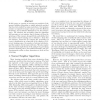Free Online Productivity Tools
i2Speak
i2Symbol
i2OCR
iTex2Img
iWeb2Print
iWeb2Shot
i2Type
iPdf2Split
iPdf2Merge
i2Bopomofo
i2Arabic
i2Style
i2Image
i2PDF
iLatex2Rtf
Sci2ools
IJCAI
1993
1993
Average-Case Analysis of a Nearest Neighbor Algorithm
In this paper we present an average-case analysis of the nearest neighbor algorithm, a simple induction method that has been studied by manyresearchers. Our analysis assumes a conjunctive target concept, noise-free Boolean attributes, and a uniform distribution over the instance space. We calculate the probability that the algorithm will encounter a test instance that is distance d from the prototype of the concept, along with the probabilitythat the nearest stored training case is distance e from this test instance. From this we compute the probability of correct classi cation as a function of the number of observed training cases, the number of relevant attributes, and the number of irrelevant attributes. We also explore the behavioral implicationsof the analysis by presenting predicted learning curves for arti cial domains, and give experimental results on these domains as a check on our reasoning.
IJCAI 1993 | IJCAI 2007 | Nearest Neighbor Algorithm | Noise-free Boolean Attributes | Test Instance |
Related Content
| Added | 02 Nov 2010 |
| Updated | 02 Nov 2010 |
| Type | Conference |
| Year | 1993 |
| Where | IJCAI |
| Authors | Pat Langley, Wayne Iba |
Comments (0)

